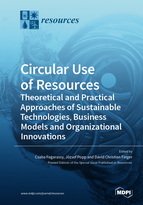Circular Use of Resources - Theoretical and Practical Approaches of Sustainable Technologies, Business Models and Organizational Innovations
A special issue of Resources (ISSN 2079-9276).
Deadline for manuscript submissions: closed (1 February 2020) | Viewed by 72502
Special Issue Editors
Interests: circular economy; bio-economy; renewable energy systems; business innovation; biological production, climate change economy
Special Issues, Collections and Topics in MDPI journals
Interests: agricultural economics; bioenergy; climate change; food security; circular economy
Special Issues, Collections and Topics in MDPI journals
Interests: environmental science earth and planetary sciences; agricultural and biological sciences; social sciences; sustainable engineering; circular innovations; alternative energy
Special Issue Information
Dear Colleagues,
Circular solutions are essential to tackle the eminent challenges of depleting resources and emerging environmental problems. The complex nature of material and energy systems and the changing economic and technological conditions are different among the EU member states as a result of the introduction and application of very different practices in developed and rapidly developing countries of the world. A wide variety of theoretical approaches can be used to facilitate a shift from the linear use of resources to circular systems, e.g., circular product planning, zero waste management, service-based repairing, refurbishing, and remanufacturing; to name just a few. The introduction and examination of circular solutions can be based on theoretical models in order to guarantee ensure successful application. Successful application of innovative technology approaches, business solutions, and organizational development can be facilitated through theoretical models and new scientific results that support innovation processes.
This Special Issue focuses on sustainable and innovative methods which help and enable the proper use and recovery of resources. Research papers, reviews, short communications, and case studies that introduce or discuss circular solutions for a sustainable use of resources are welcomed. In particular, we encourage the submission of papers on circular manufacturing, sustainable digitalization, platform sharing, up- and down cycling, reusing, refurbishing, leasing, servicing, loaning, and capacity sharing.
The following papers are examples of the scope of the Special Issue:
Horvath, B.; Mallinguh, E.; Fogarassy, C. Designing Business Solutions for Plastic Waste Management to Enhance Circular Transitions in Kenya. Sustainability 2018, 10, 1664.
Fogarassy, C.; Neubauer, E.; Mansur, H.; Tangl, A.; Oláh, J.; Popp, J. The main transition management issues and the effects of environmental accounting on financial performance – with focus on cement industry. Administratie si Management Public 2018, (31), pp. 52-66.
Horvath, B.; Khazami, N.; Ymeri, P.; Fogarassy, C. Investigating the Current Business Model Innovation Trends in the Biotechnology Industry. JBEM 2019, 20, 63-85.
Prof. Dr. József Popp
Dr. Csaba Fogarassy
Dr. David Christian Finger
Guest Editors
Manuscript Submission Information
Manuscripts should be submitted online at www.mdpi.com by registering and logging in to this website. Once you are registered, click here to go to the submission form. Manuscripts can be submitted until the deadline. All submissions that pass pre-check are peer-reviewed. Accepted papers will be published continuously in the journal (as soon as accepted) and will be listed together on the special issue website. Research articles, review articles as well as short communications are invited. For planned papers, a title and short abstract (about 100 words) can be sent to the Editorial Office for announcement on this website.
Submitted manuscripts should not have been published previously, nor be under consideration for publication elsewhere (except conference proceedings papers). All manuscripts are thoroughly refereed through a single-blind peer-review process. A guide for authors and other relevant information for submission of manuscripts is available on the Instructions for Authors page. Resources is an international peer-reviewed open access monthly journal published by MDPI.
Please visit the Instructions for Authors page before submitting a manuscript. The Article Processing Charge (APC) for publication in this open access journal is 1600 CHF (Swiss Francs). Submitted papers should be well formatted and use good English. Authors may use MDPI's English editing service prior to publication or during author revisions.
Keywords
- biological loops
- business model application
- circular innovation
- circular manufacturing
- closed loop energy system
- environmental engineering
- industrial circulation
- renewable energy management
- resource management
- service-based economy
- sharing economy
- sharing platforms
- sustainable digitalization
- technological cycles
- water management








